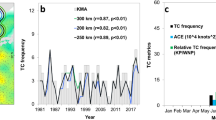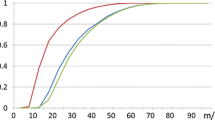Summary
The number of tropical cyclones observed in the Australian region (south of equator; 105–160° E) has apparently declined since the start of reliable (satellite) observations in the 1969/70 season. However, the number of more intense cyclones (with minimum pressures dropping to 970 hPa or lower) has increased slightly. The numbers of weak (minimum pressures not dropping below 990 hPa) and moderate systems (minimum pressures between 970 and 990 hPa) have declined. Possible reasons for these different trends are discussed. The decline in the number of weaker cyclones may at least partly reflect improved understanding of the nature of some weak systems. The decline in the number of cyclones more intense than 990 hPa primarily reflects the downward trend in the Southern Oscillation Index (SOI). Previous work has demonstrated that the number of tropical cyclones observed in the Australian region each cyclone season is related to the value of the SOI prior to the start of the cyclone season. This relationship is clearest with the number of moderate cyclones. The SOI is only weakly related to the number of intense or weak cyclones. The increase in the number of intense cyclones is not attributable to the trend in the SOI. Nor is there clear reason, at present, to suspect that it is artificial (i.e., due to changes in observing or analysis techniques).
Similar content being viewed by others
References
Basher, R. E., Zheng, X., 1995: Tropical cyclones in the Southwest Pacific: Spatial patterns and relationships to the Southern Oscillation and sea surface temperature.J. Climate,8, 1249–1260.
Chan, J. C. L., Shi, J., 1996: Long-term trends in interannual variability in tropical cyclone activity over the western North Pacific.Geophys. Res. Letts.,23, 2765–2767.
Dong, K., 1988: El Niño and tropical cyclone frequency in the Australian region and the northwest Pacific.Aust. Met. Mag.,36, 219–225.
Evans, J. L., Allan, R. J., 1992: El Niño/Southern oscillation modification to the structure of the monsoon and tropical cyclone activity in the Australasian region.Int. J. Climatol.,12, 611–623.
Hastings, P. A., 1990: Southern Oscillation influences on tropical cyclone activity in the Australian/Southwest Pacific region.Int. J. Climatol.,10, 291–298.
Holland, G. J., 1981: On the quality of the Australian tropical cyclone data base.Aust. Meteorol. Mag.,29, 169–181.
Landsea, C. W., Nicholls, N., Gray, W. M., Avila, L. A., 1996: Downward trend in the frequency of intense Atlantic hurricanes during the past five decades.Geophys. Res. Letts.,23, 1697–1700.
Nicholls, N., 1979: A possible method for predicting seasonal tropical cyclone activity in the Australian region.Mon. Wea. Rev.,107, 1221–1224.
Nicholls, N., 1984: The Southern Oscillation, sea-surface temperature, and interannual fluctuations in Australian tropical cyclone activity.J. Climatol.,4, 661–670.
Nicholls, N., 1985: Predictability of interannual variations of Australian seasonal tropical cyclone activity.Mon. Wea. Rev.,113, 1144–1149.
Nicholls, N., 1992: Recent performance of a method for forecasting Australian seasonal tropical cyclone activity.Aust. Meteor. Mag.,40, 105–110.
Revell, C. G., Goulter, S. W., 1986a: South Pacific tropical cyclones and the Southern Oscillation.Mon. Wea. Rev.,114, 1138–1145.
Revell, C. G., Goulter, S. W., 1986b: Lagged relationships between the Southern Oscillation and numbers of tropical cyclones in the south Pacific region.Mon. Wea. Rev.,114, 2669–2670.
Solow, A., Nicholls, N., 1990: The relationship between the Southern Oscillation and tropical cyclone frequency in the Australian region.J. Climate,3, 1097–1101.
Torok, S. J., Nicholls, N., 1996: A historical annual temperature data set for Australia.Aust. Met. Mag.,45, 251–260.
Trenberth, K. E., Hoar, T. J., 1996: The 1990–1995 El Niño-Southern Oscillation event: Longest on record.Geophys. Res. Letts.,23, 57–60.
Author information
Authors and Affiliations
Additional information
With 7 Figures
Rights and permissions
About this article
Cite this article
Nicholls, N., Landsea, C. & Gill, J. Recent trends in Australian region tropical cyclone activity. Meteorl. Atmos. Phys. 65, 197–205 (1998). https://doi.org/10.1007/BF01030788
Received:
Issue Date:
DOI: https://doi.org/10.1007/BF01030788




